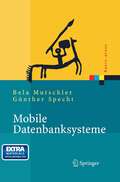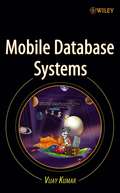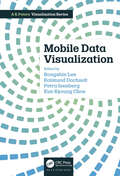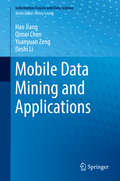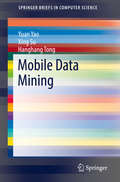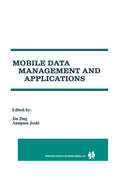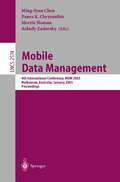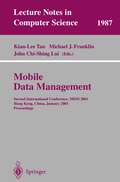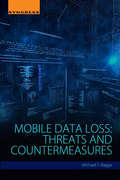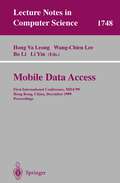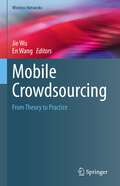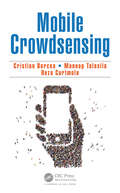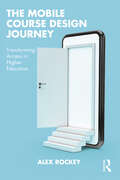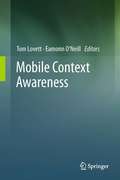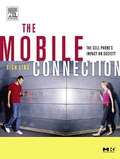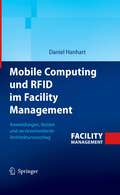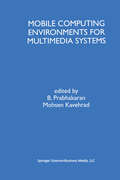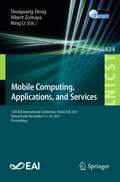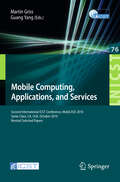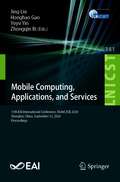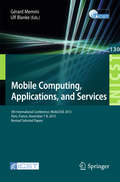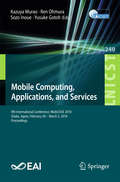- Table View
- List View
Mobile Datenbanksysteme: Architektur, Implementierung, Konzepte (Xpert.press)
by Bela Mutschler Günther SpechtMobile Database Systems
by Vijay KumarA breakthrough sourcebook to the challenges and solutions for mobile database systems This text enables readers to effectively manage mobile database systems (MDS) and data dissemination via wireless channels. The author explores the mobile communication platform and analyzes its use in the development of a distributed database management system. Workable solutions for key challenges in wireless information management are presented throughout the text. Following an introductory chapter that includes important milestones in the history and development of mobile data processing, the text provides the information, tools, and resources needed for MDS management, including: * Fundamentals of wireless communication * Location and handoff management * Fundamentals of conventional database management systems and why existing approaches are not adequate for mobile databases * Concurrency control mechanism schemes * Data processing and mobility * Management of transactions * Mobile database recovery schemes * Data dissemination via wireless channels Case studies and examples are used liberally to aid in the understanding and visualization of complex concepts. Various exercises enable readers to test their grasp of each topic before advancing in the text. Each chapter also concludes with a summary of key concepts as well as references for further study. Professionals in the mobile computing industry, particularly e-commerce, will find this text indispensable. With its extensive use of case studies, examples, and exercises, it is also highly recommended as a graduate-level textbook.
Mobile Data Visualization (AK Peters Visualization Series)
by Bongshin LeeMobile Data Visualization is about facilitating access to and understanding of data on mobile devices. Wearable trackers, mobile phones, and tablets are used by millions of people each day to read weather maps, financial charts, or personal health meters. What is required to create effective visualizations for mobile devices? This book introduces key concepts of mobile data visualization and discusses opportunities and challenges from both research and practical perspectives. Mobile Data Visualization is the first book to provide an overview of how to effectively visualize, analyze, and communicate data on mobile devices. Drawing from the expertise, research, and experience of an international range of academics and practitioners from across the domains of Visualization, Human Computer Interaction, and Ubiquitous Computing, the book explores the challenges of mobile visualization and explains how it differs from traditional data visualization. It highlights opportunities for reaching new audiences with engaging, interactive, and compelling mobile content. In nine chapters, this book presents interesting perspectives on mobile data visualization including: how to characterize and classify mobile visualizations; how to interact with them while on the go and with limited attention spans; how to adapt them to various mobile contexts; specific methods on how to design and evaluate them; reflections on privacy, ethical and other challenges, as well as an outlook to a future of ubiquitous visualization. This accessible book is a valuable and rich resource for visualization designers, practitioners, researchers, and students alike.
Mobile Data Visualization (AK Peters Visualization Series)
by Bongshin Lee Raimund Dachselt Petra Isenberg Eun Kyoung ChoeMobile Data Visualization is about facilitating access to and understanding of data on mobile devices. Wearable trackers, mobile phones, and tablets are used by millions of people each day to read weather maps, financial charts, or personal health meters. What is required to create effective visualizations for mobile devices? This book introduces key concepts of mobile data visualization and discusses opportunities and challenges from both research and practical perspectives. Mobile Data Visualization is the first book to provide an overview of how to effectively visualize, analyze, and communicate data on mobile devices. Drawing from the expertise, research, and experience of an international range of academics and practitioners from across the domains of Visualization, Human Computer Interaction, and Ubiquitous Computing, the book explores the challenges of mobile visualization and explains how it differs from traditional data visualization. It highlights opportunities for reaching new audiences with engaging, interactive, and compelling mobile content. In nine chapters, this book presents interesting perspectives on mobile data visualization including: how to characterize and classify mobile visualizations; how to interact with them while on the go and with limited attention spans; how to adapt them to various mobile contexts; specific methods on how to design and evaluate them; reflections on privacy, ethical and other challenges, as well as an outlook to a future of ubiquitous visualization. This accessible book is a valuable and rich resource for visualization designers, practitioners, researchers, and students alike.
Mobile Data Mining and Applications (Information Fusion and Data Science)
by Hao Jiang Qimei Chen Yuanyuan Zeng Deshi LiThis book focuses on mobile data and its applications in the wireless networks of the future. Several topics form the basis of discussion, from a mobile data mining platform for collecting mobile data, to mobile data processing, and mobile feature discovery. Usage of mobile data mining is addressed in the context of three applications: wireless communication optimization, applications of mobile data mining on the cellular networks of the future, and how mobile data shapes future cities. In the discussion of wireless communication optimization, both licensed and unlicensed spectra are exploited. Advanced topics include mobile offloading, resource sharing, user association, network selection and network coexistence. Mathematical tools, such as traditional convexappl/non-convex, stochastic processing and game theory are used to find objective solutions. Discussion of the applications of mobile data mining to cellular networks of the future includes topics such as green communication networks, 5G networks, and studies of the problems of cell zooming, power control, sleep/wake, and energy saving. The discussion of mobile data mining in the context of smart cities of the future covers applications in urban planning and environmental monitoring: the technologies of deep learning, neural networks, complex networks, and network embedded data mining. Mobile Data Mining and Applications will be of interest to wireless operators, companies, governments as well as interested end users.
Mobile Data Mining (SpringerBriefs in Computer Science)
by Yuan Yao Xing Su Hanghang TongThis SpringerBrief presents a typical life-cycle of mobile data mining applications, including:data capturing and processing which determines what data to collect, how to collect these data, and how to reduce the noise in the data based on smartphone sensors feature engineering which extracts and selects features to serve as the input of algorithms based on the collected and processed data model and algorithm designIn particular, this brief concentrates on the model and algorithm design aspect, and explains three challenging requirements of mobile data mining applications: energy-saving, personalization, and real-time Energy saving is a fundamental requirement of mobile applications, due to the limited battery capacity of smartphones. The authors explore the existing practices in the methodology level (e.g. by designing hierarchical models) for saving energy. Another fundamental requirement of mobile applications is personalization. Most of the existing methods tend to train generic models for all users, but the authors provide existing personalized treatments for mobile applications, as the behaviors may differ greatly from one user to another in many mobile applications. The third requirement is real-time. That is, the mobile application should return responses in a real-time manner, meanwhile balancing effectiveness and efficiency. This SpringerBrief targets data mining and machine learning researchers and practitioners working in these related fields. Advanced level students studying computer science and electrical engineering will also find this brief useful as a study guide.
Mobile Data Management and Applications
by Jin Jin Jing Anupam JoshiMobile Data Management and Applications brings together in one place important contributions and up-to-date research results in this fast moving area. Mobile Data Management and Applications serves as an excellent reference, providing insight into some of the most challenging research issues in the field.
Mobile Data Management: 4th International Conference, MDM 2003, Melbourne, Australia, January 21-24, 2003, Proceedings (Lecture Notes in Computer Science #2574)
by Ming-Syan Chen Panos K. Chrysanthis Morris Sloman Arkady ZaslavskyWe are rapidly heading towards a world in which the computing infrastructure will contain billions of devices, which will interact with other computing/communications devices that are carried or worn by users as they go through their daily routines. Such devices will provide data access to mobile users as they move within buildings, cities, or across the globe. This new infrastructure presents tremendous challenges for data management technology, including: huge scale; variable and intermittent connectivity; location and context-aware applications; bandwidth, power, and devi- size limitations; and multimedia data delivery across hybrid networks and systems. Traditional data management technologies such as query processing, transaction management, workflow, business process management, and metadata management must all be reevaluated in this emerging environment. Furthermore, nontraditional issues such as the semantics of mobile data, location-dependent querying, broadcast and multicast delivery, and caching/prefetching techniques must all be addressed. The ability to track people as they move about their daily tasks raises serious issues of security and privacy. This conference is the fourth in the Mobile Data Management series, focusing on the challenges and opportunities for the management of data in mobile, pervasive, and wearable computing. MDM 2000 and 2001 were in Hong Kong and MDM 2002 was in Singapore. Eighty-seven papers were submitted to the conference from 23 countries and were subject to a rigorous review procedure. Every paper had three or four independent reviews. Twenty-one full papers and 15 short papers from both academia and industry were selected for publication in this volume of proceedings.
Mobile Data Management: Second International Conference, MDM 2001 Hong Kong, China, January 8-10, 2001 Proceedings (Lecture Notes in Computer Science #1987)
by Kian-Lee Tan Michael J. Franklin John C. S. LuiWelcome to the Second International Conference on Mobile Data Management (MDM2001). The conference serves as a forum for the exchange of technical ideas and research results in the areas of mobility and database management. This year, we have a very exciting program for MDM2001. Many quality papers were submitted to the conference. All of the submitted papers were - viewed by at least three PC members. Due to the limitations of the program schedule as well as the desire to organize the conference using a single track format, we selected only 18 papers for full presentation at the conference. As a result many excellent papers could not be accepted. The papers chosen for presentation span a large range of topics, from n- work protocol issues up to the semantics of mobile applications. The common theme of all these papers is their recognition of the central role played by data managementtechniques in the developmentof the emerging worldof mobile and wireless applications. We have loosely organized these papers into six areas: 1. DATA MANAGEMENT ARCHITECTURES, 2. CONTENT DELIVERY, 3. DATA BROADCASTING, 4. CACHING AND HOARDING, 5. COPING WITH MOVEMENT, 6. NETWORKS AND SYSTEMS ISSUES In addition to the researchtrack, we havesought to broaden the scope of the conference with an industrial session as well as poster presentations. Overall, the program strikes a comfortable balance between applied and theoretically oriented papers.
Mobile Data Loss: Threats and Countermeasures
by Michael T. RaggoThe mobile threat landscape is evolving bringing about new forms of data loss. No longer can organizations rely on security policies designed during the PC era. Mobile is different and therefore requires a revised approach to countermeasures to mitigate data loss. Understanding these differences is fundamental to creating a new defense-in-depth strategy designed for mobile. Mobile Data Loss: Threats & Countermeasures reviews the mobile threat landscape using a hacker mind-set to outline risks and attack vectors that include malware, risky apps, operating system compromises, network attacks, and user behaviours. This provides the basis for then outlining countermeasures for defining a holistic mobile security methodology that encompasses proactive protections, response mechanisms, live monitoring, and incident response. Designing a comprehensive mobile security strategy is key. Mobile Data Loss: Threats & Countermeasures outlines the threats and strategies for protecting devices from a plethora of data loss vectors. Outlines differences in mobile devices versus PCsReviews mobile threat landscape using a hacker mind-set to outline risks and attack vectorsSummarizes the tools and techniques for implementing enterprise countermeasuresMaps mobile to common security compliances including PCI, HIPAA, and CJISProvides a defense-in-depth methodology and strategy for enterprises to minimize data loss
Mobile Data Access: First International Conference, MDA'99, Hong Kong, China, December 16-17, 1999 Proceedings (Lecture Notes in Computer Science #1748)
by Hong Va Leong Wang-Chien Lee Bo Li Li YinMobile Crowdsourcing: From Theory to Practice (Wireless Networks)
by Jie Wu En WangThis book offers the latest research results in recent development on the principles, techniques and applications in mobile crowdsourcing. It presents state-of-the-art content and provides an in-depth overview of the basic background in this related field. Crowdsourcing involves a large crowd of participants working together to contribute or produce goods and services for the society. The early 21st century applications of crowdsourcing can be called crowdsourcing 1.0, which includes businesses using crowdsourcing to accomplish various tasks, such as the ability to offload peak demand, access cheap labor, generate better results in a timely matter, and reach a wider array of talent outside the organization. Mobile crowdsensing can be described as an extension of crowdsourcing to the mobile network to combine the idea of crowdsourcing with the sensing capacity of mobile devices. As a promising paradigm for completing complex sensing and computation tasks, mobile crowdsensing serves the vital purpose of exploiting the ubiquitous smart devices carried by mobile users to make conscious or unconscious collaboration through mobile networks. Considering that we are in the era of mobile internet, mobile crowdsensing is developing rapidly and has great advantages in deployment and maintenance, sensing range and granularity, reusability, and other aspects. Due to the benefits of using mobile crowdsensing, many emergent applications are now available for individuals, business enterprises, and governments. In addition, many new techniques have been developed and are being adopted. This book will be of value to researchers and students targeting this topic as a reference book. Practitioners, government officials, business organizations and even customers -- working, participating or those interested in fields related to crowdsourcing will also want to purchase this book.
Mobile Crowdsensing
by Cristian Borcea Manoop Talasila Reza CurtmolaMobile crowdsensing is a technology that allows large scale, cost-effective sensing of the physical world. In mobile crowdsensing, mobile personal devices such as smart phones or smart watches come equipped with a variety of sensors that can be leveraged to collect data related to environment, transportation, healthcare, safety and so on. This book presents the first extensive coverage of mobile crowdsensing, with examples and insights drawn from the authors’ extensive research on this topic as well as from the research and development of a growing community of researchers and practitioners working in this emerging field. Throughout the text, the authors provide the reader with various examples of crowdsensing applications and the building blocks to creating the necessary infrastructure, explore the related concepts of mobile sensing and crowdsourcing, and examine security and privacy issues introduced by mobile crowdsensing platforms. Provides a comprehensive description of mobile crowdsensing, a one-stop shop for all relevant issues pertaining to mobile crowdsensing, including motivation, applications, design and implementation, incentive mechanisms, and reliability and privacy. Describes the design and implementations of mobile crowdsensing platforms of great interest for the readers working in research and industry to quickly implement and test their systems. Identifies potential issues in building such mobile crowdsensing applications to ensure their usability in real life and presents future directions in mobile crowdsensing by emphasizing the open problems that have to be addressed.
Mobile Crowdsensing
by Cristian Borcea Manoop Talasila Reza CurtmolaMobile crowdsensing is a technology that allows large scale, cost-effective sensing of the physical world. In mobile crowdsensing, mobile personal devices such as smart phones or smart watches come equipped with a variety of sensors that can be leveraged to collect data related to environment, transportation, healthcare, safety and so on. This book presents the first extensive coverage of mobile crowdsensing, with examples and insights drawn from the authors’ extensive research on this topic as well as from the research and development of a growing community of researchers and practitioners working in this emerging field. Throughout the text, the authors provide the reader with various examples of crowdsensing applications and the building blocks to creating the necessary infrastructure, explore the related concepts of mobile sensing and crowdsourcing, and examine security and privacy issues introduced by mobile crowdsensing platforms. Provides a comprehensive description of mobile crowdsensing, a one-stop shop for all relevant issues pertaining to mobile crowdsensing, including motivation, applications, design and implementation, incentive mechanisms, and reliability and privacy. Describes the design and implementations of mobile crowdsensing platforms of great interest for the readers working in research and industry to quickly implement and test their systems. Identifies potential issues in building such mobile crowdsensing applications to ensure their usability in real life and presents future directions in mobile crowdsensing by emphasizing the open problems that have to be addressed.
The Mobile Course Design Journey: Transforming Access in Higher Education
by Alex RockeyThe Mobile Course Design Journey provides practical strategies to college and university educators and faculty support professionals looking to develop accessible mobile learning experiences. Given the near-ubiquity of mobile device ownership today, creating courses that can be completed entirely on a mobile device is essential to captivating student attention and supporting equity-minded pedagogy. This book frames effective mobile design within a continuum in which educators can make gradual yet meaningful changes to their instruction and course content while leveraging learners’ existing tools and literacies. Original, ready-to-use features such as a rubric for evaluating the mobile-friendliness of course content and assignments as well as a toolkit for leading workshops on mobile design will further help to demystify mobile learning in higher education.
The Mobile Course Design Journey: Transforming Access in Higher Education
by Alex RockeyThe Mobile Course Design Journey provides practical strategies to college and university educators and faculty support professionals looking to develop accessible mobile learning experiences. Given the near-ubiquity of mobile device ownership today, creating courses that can be completed entirely on a mobile device is essential to captivating student attention and supporting equity-minded pedagogy. This book frames effective mobile design within a continuum in which educators can make gradual yet meaningful changes to their instruction and course content while leveraging learners’ existing tools and literacies. Original, ready-to-use features such as a rubric for evaluating the mobile-friendliness of course content and assignments as well as a toolkit for leading workshops on mobile design will further help to demystify mobile learning in higher education.
Mobile Context Awareness
by Tom Lovett and Eamonn O'NeillMobile context-awareness is a popular research trend in the field of ubiquitous computing. Advances in mobile device sensory hardware and the rise of ‘virtual’ sensors such as web application programming interfaces (APIs) mean that the mobile user is exposed to a vast range of data that can be used for new advanced applications. Mobile Context Awareness presents work from industrial and academic researchers, focusing on novel methods of context acquisition in the mobile environment – particularly through the use of physical and virtual sensors – along with research into new applications utilising this context. In addition, the book provides insights into the technical and usability challenges involved in mobile context-awareness, as well as observations on current and future trends in the field.
The Mobile Connection: The Cell Phone's Impact on Society (Interactive Technologies)
by Rich LingHas the cell phone forever changed the way people communicate? The mobile phone is used for “real time" coordination while on the run, adolescents use it to manage their freedom, and teens “text" to each other day and night. The mobile phone is more than a simple technical innovation or social fad, more than just an intrusion on polite society. This book, based on world-wide research involving tens of thousands of interviews and contextual observations, looks into the impact of the phone on our daily lives. The mobile phone has fundamentally affected our accessibility, safety and security, coordination of social and business activities, and use of public places. Based on research conducted in dozens of countries, this insightful and entertaining book examines the once unexpected interaction between humans and cell phones, and between humans, period. The compelling discussion and projections about the future of the telephone should give designers everywhere a more informed practice and process, and provide researchers with new ideas to last years.*Rich Ling (an American working in Norway) is a prominent researcher, interviewed in the new technology article in the November 9 issue of the New York Times Magazine. *A particularly "good read", this book will be important to the designers, information designers, social psychologists, and others who will have an impact on the development of the new third generation of mobile telephones. *Carefully and wittily written by a senior research scientist at Telenor, Norway's largest telecommunications company, and developer of the first mobile telephone system that allowed for international roaming.
Mobile Computing und RFID im Facility Management: Anwendungen, Nutzen und serviceorientierter Architekturvorschlag
by Daniel HanhartMobile Computing und RFID (Radio Frequency Identification) werden die Abläufe im Facility Management (FM) in Zukunft stark verändern. Das vorliegende Buch beschreibt systematisch die Anwendungsgebiete und Potentiale sowie die Möglichkeiten zur objektiven Bewertung der neuen Funktechnologien. Es entstehen integrierte, transparente und in Echtzeit ablaufende Prozesse, die die Kosten reduzieren und die Kundenzufriedenheit erhöhen. Außerdem beschreibt der Autor anhand eines Falles aus der Praxis die effiziente Umsetzung. Mit Hilfe einer serviceorientierten Architektur (SOA) können – anders als bei klassischen Ansätzen – die Geschäftsprozesse eines FM-Unternehmens durch loses Koppeln von wiederverwendbaren „Services" flexibel realisiert werden. Dies erhöht die unternehmerische Agilität und die Umsetzungsgeschwindigkeit von Mobile Computing und RFID und ist die Voraussetzung für eine zukunftsgerichtete Investition.
Mobile Computing Environments for Multimedia Systems: A Special Issue of Multimedia Tools and Applications An International Journal Volume 9, No. 1 (1999)
by B. Prabhakaran Mohsen KavehradMobile Computing Environments for Multimedia Systems brings together in one place important contributions and up-to-date research results in this fast moving area. Mobile Computing Environments for Multimedia Systems serves as an excellent reference, providing insight into some of the most challenging research issues in the field.
Mobile Computing, Applications, and Services: 12th EAI International Conference, MobiCASE 2021, Virtual Event, November 13–14, 2021, Proceedings (Lecture Notes of the Institute for Computer Sciences, Social Informatics and Telecommunications Engineering #434)
by Shuiguang Deng Albert Zomaya Ning LiThis book constitutes the thoroughly refereed post-conference proceedings of the 12th International Conference on Mobile Computing, Applications, and Services, MobiCASE 2021, held in November 2021. Due to COVID-19 pandemic the conference was held virtually. The 9 full papers were carefully reviewed and selected from 21 submissions. The papers are organized in two topical tracks: mobile application and deep learning, and mobile application with data analysis.
Mobile Computing, Applications, and Services: Second International ICST Conference, MOBICASE 2010, Santa Clara, CA, USA, October 25-28, 2010, Revised Selected Papers (Lecture Notes of the Institute for Computer Sciences, Social Informatics and Telecommunications Engineering #76)
by Martin Griss Guang YangThis book constitutes the thoroughly refereed post-conference proceedings of the Second International Conference on Mobile Computing, Applications, and Services (MobiCASE 2010) held in Santa Clara, CA, USA, during October 25-28, 2010. The 15 revised full papers presented were carefully selected from numerous submissions. Conference papers are organized in six technical sessions, covering the topics of mobile Web and mash-ups, software engineering and development tools, cross-layer approaches, location-based services, mobile healthcare, and mobile social networking. Furthermore the volume includes two workshops on mobile computing and mobile security as well as four poster papers.
Mobile Computing, Applications, and Services: 11th EAI International Conference, MobiCASE 2020, Shanghai, China, September 12, 2020, Proceedings (Lecture Notes of the Institute for Computer Sciences, Social Informatics and Telecommunications Engineering #341)
by Jing Liu Honghao Gao Yuyu Yin Zhongqin BiThis book constitutes the thoroughly refereed post-conference proceedings of the 11th International Conference on Mobile Computing, Applications, and Services, MobiCASE 2020, held in Shanghai, China, in September 2020. The conference was held virtually due to the COVID-19 pandemic.The 15 full papers were carefully reviewed and selected from 49 submissions. The papers are organized in topical sections on mobile application and framework; mobile application with data analysis; and AI application.
Mobile Computing, Applications, and Services: 5th International Conference, MobiCase 2013, Paris, France, November 7-8, 2013, Revised Selected Papers (Lecture Notes of the Institute for Computer Sciences, Social Informatics and Telecommunications Engineering #130)
by Gerard Memmi Ulf BlankeThis book constitutes the thoroughly refereed post-conference proceedings of the 5th International Conference on Mobile Computing, Applications, and Services (MobiCASE 2013) held in Paris, France, in November 2013. The 13 full, 5 short and 9 poster papers were carefully reviewed and selected from 64 submissions, and are presented together with 3 papers from the Workshop on Near Field Communication for Mobile Applications (NFS). The conference papers are covering mobile applications development, mobile social networking, novel user experience and interfaces, mobile services and platforms such as Android, iOS, BlackBerry OS, Windows phone, Bada, mobile software engineering and mobile Web, mobile payments and M2M infrastructure, mobile services such as novel hardware add-ons, energy aware services or tools, NFC-based services, authentication services.
Mobile Computing, Applications, and Services: 9th International Conference, MobiCASE 2018, Osaka, Japan, February 28 – March 2, 2018, Proceedings (Lecture Notes of the Institute for Computer Sciences, Social Informatics and Telecommunications Engineering #240)
by Kazuya Murao Ren Ohmura Sozo Inoue Yusuke GotohThis book constitutes the thoroughly refereed post-conference proceedings of the 9th International Conference on Mobile Computing, Applications, and Services (MobiCASE 2015) held in Osaka, Japan, February 28 – March 2, 2018. The 10 full papers and 13 demo/ poster papers were carefully reviewed and selected from 35 submissions. The conference papers are covering intelligent caching; activity recognition and crowdsourcing; mobile frameworks; middleware; interactive applications; and mobility.
